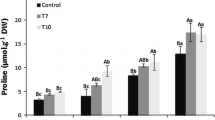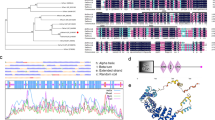Abstract
A phytoene synthase gene SePSY was isolated from euhalophyte Salicornia europaea L. The 1655 bp full-length SePSY has an open reading frame of 1257 bp and encodes a 419-amino acid protein. The overexpression of SePSY enhanced the growth of transgenic Arabidopsis. When the plants were exposed to 100 mM NaCl, the photosynthesis rate and photosystem II activity (Fv/Fm) increased from 92% to 132% and from 9.3% to 16.6% in the transgenic lines than in the wild-type, respectively. The transgenics displayed higher activities of SOD and POD and lower contents of H2O2 and MDA than the WT. In conclusion, the transgenic lines showed higher tolerance to salt stress than WT plants by increased photosynthesis efficiency and antioxidative capacity. This is the first report about improving the salt tolerance by genetic manipulation of carotenoid biosynthesis.




Similar content being viewed by others
References
Bartels D, Sunkar R (2005) Drought and salt tolerance in plants. Critical Rev Plant Sci 24:23–58
Bartley GE, Scolnik PA (1994) Molecular biology of carotenoid biosynthesis in plants. Annu Rev Plant Physiol Plant Mol Biol 45:287–301
Blokhina O, Virolainen E, Fagerstedt KV (2003) Antioxidants, oxidative damage and oxygen deprivation stress: a review. Ann Botany 91:179–194
Clough SJ, Bent AF (1998) Floral dip: a simplified method for agrobacterium-mediated transformation of Arabidopsis thaliana. Plant J 16:735–743
Cunningham JFX, Gantt E (1998) Genes and enzymes of carotenoid biosynthesis in plants. Annu Rev Plant Physiol 49:557–583
Davison PA, Hunter CN, Horton P (2002) Overexpression of β-carotene hydroxylase enhances stress tolerance in Arabidopsis. Nature 418:203–206
Demming-Adams B (1990) Carotenoids and photoprotection in plants: a role of the xanthophylls zeaxanthin. Biochem Biophys Acta 1020:1–24
Izumi CM, Schroeder JI (2004) Reactive oxygen species activation of plant Ca2+ channels: a signaling mechanism in polar growth, hormone transduction, stress signaling, and hypothetically mechanotransduction. Plant Physiol 135:702–708
Kotchoni SO, Kuhns C, Ditzer A, Kirch H, Bartels D (2006) Over-expression of different aldehyde dehydrogenase genes in Arabidopsis thaliana confers tolerance to abiotic stress and protects plants against lipid peroxidation and oxidative stress. Plant Cell Environ 29:1033–1048
Krinsky NI (1989) Antioxidant functions of carotenoids. Free Radic Biol Med 7:617–635
Li FQ, Vallabhaneni R, Wurtzel ET (2007) PSY3, a new member of the phytoene synthase gene family conserved in the Poaceae and regulator of abiotic-stress-induced root carotenogenesis. Plant Physiol 10.1104/pp.107.111120
Møller IM (2001) Plant mitochondria and oxidative stress: electron transport, NADPH turnover, and metabolism of reactive oxygen species. Annu Rev Plant Physiol Plant Mol Biol 52:561–591
Parida AK, Das AB, Mohanty P (2004) Defense potentials to NaCl in a mangrove, Bruguiera parviflora: differential changes of isoforms of some antioxidative enzymes. J Plant Physiol 161:531–542
Römer S, Fraser PD (2005) Recent advances in carotenoid biosynthesis regulation and manipulation. Planta 221:305–308
Ruban AV, Berera R, Ilioaia C, van Stokkum IHM, Kennis JTM, Pascal AA, van Amerongen H, Robert B, Horton P, van Grondelle R (2007) Identification of a mechanism of photoprotective energy dissipation in higher plants. Nature 450:575–579
Salvini M, Bernini A, Fambrini M, Pugliesi C (2005) cDNA cloning and expression of the phytoene synthase gene in sunflower. J Plant Physiol 162:479–484
Sambrook J, Fritsch EF, Maniatis T (1989) Molecular cloning: a laboratory manual, 2nd edn. Cold Spring Harbor Press, Cold Spring Harbor
Sandmann G (2001) Genetic manipulation of carotenoid biosynthesis: strategies, problems and achievements. Trends Plant Sci 6:13–17
Schledz M, Al-Babili S, Lintig J, Haubruck H, Rabbani S, Kleinig H, Beyer P (1996) Phytoene synthase from Narcissus pseudonarcissus: functional expression, galactolipid requirement, topological distribution in chromoplasts and induction during flowering. Plant J 10:781–792
Scolnik PA, Bartley GE (1994) Nucleotide sequence of an Arabidopsis cDNA for phytoene synthase. Plant Physiol 104:1471–1472
Tao NG, Hu ZY, Liu Q, Xu J, Cheng YJ, Guo LL, Guo WW, Deng XX (2007) Expression of phytene synthase gene (Psy) is enhanced during fruit ripening of Cara Cara navel orange (Citrus sinensis Osbeck). Plant Cell Rep 26:837–843
Telfer A (2005) Too much light? How β-carotene protects the photosystem II reaction centre. Photochem Photobiol Sci 4:950–956
Ye XD, Al-Babili S, Kloti A, Zhang J, Lucca P (2000) Engineering the provitamin A (β-carotene) biosynthetic pathway into (carotenoid-free) rice endosperm. Science 287:303–305
Zhu JK (2002) Salt and drought stress signal transduction in plants. Annu Rev Plant Biol 53:247–273
Acknowledgements
This work was financially supported by the National High Technology and Research Development Program of China (“863” project) (Grant No.2003AA627010 and No.2007AA091705).
Author information
Authors and Affiliations
Corresponding author
Rights and permissions
About this article
Cite this article
Han, H., Li, Y. & Zhou, S. Overexpression of phytoene synthase gene from Salicornia europaea alters response to reactive oxygen species under salt stress in transgenic Arabidopsis. Biotechnol Lett 30, 1501–1507 (2008). https://doi.org/10.1007/s10529-008-9705-6
Received:
Revised:
Accepted:
Published:
Issue Date:
DOI: https://doi.org/10.1007/s10529-008-9705-6




